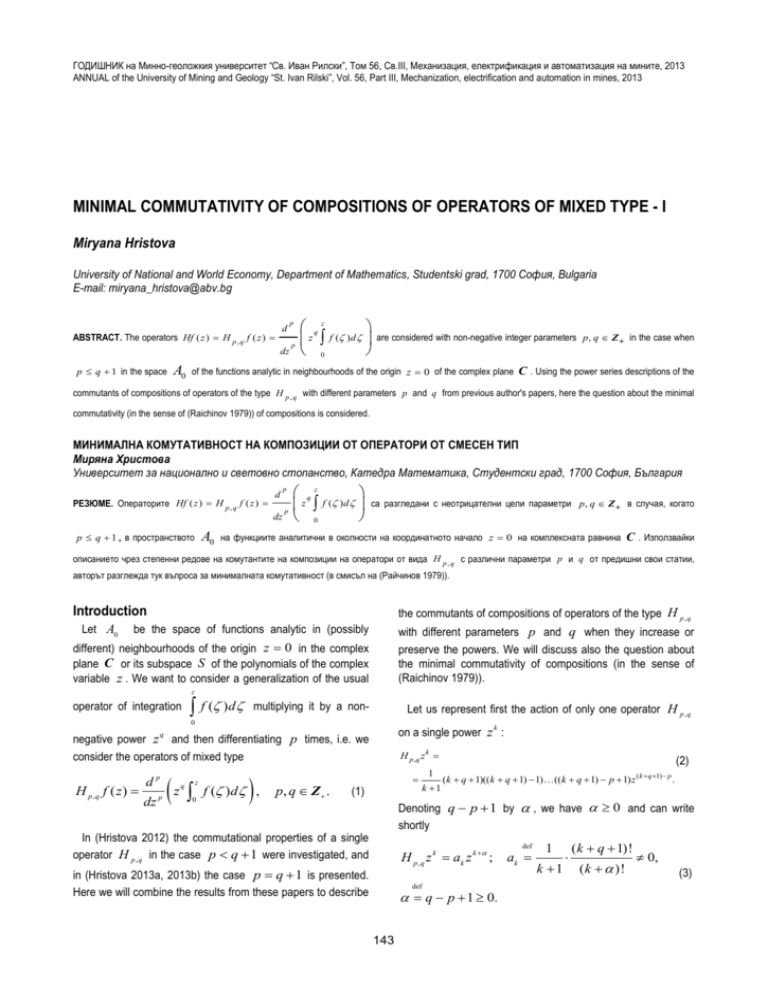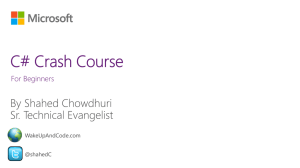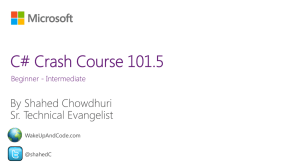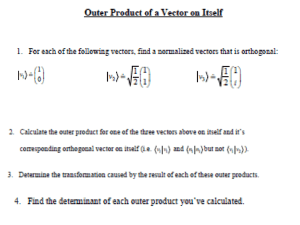осем празни реда - само на първата страница - Минно
advertisement

ГОДИШНИК на Минно-геоложкия университет “Св. Иван Рилски”, Том 56, Св.IІІ, Механизация, електрификация и автоматизация на мините, 2013
ANNUAL of the University of Mining and Geology “St. Ivan Rilski”, Vol. 56, Part ІІІ, Mechanization, electrification and automation in mines, 2013
MINIMAL COMMUTATIVITY OF COMPOSITIONS OF OPERATORS OF MIXED TYPE - I
Miryana Hristova
University of National and World Economy, Department of Mathematics, Studentski grad, 1700 София, Bulgaria
E-mail: miryana_hristova@abv.bg
d
ABSTRACT. The operators Hf ( z ) H p , q f ( z )
dz
p q 1 in the space
A0
p
p
qz
z f ( ) d
0
are considered with non-negative integer parameters p , q Z + in the case when
of the functions analytic in neighbourhoods of the origin z 0 of the complex plane
C . Using the power series descriptions of the
commutants of compositions of operators of the type H p , q with different parameters p and q from previous author's papers, here the question about the minimal
commutativity (in the sense of (Raichinov 1979)) of compositions is considered.
МИНИМАЛНА КОМУТАТИВНОСТ НА КОМПОЗИЦИИ ОТ ОПЕРАТОРИ ОТ СМЕСЕН ТИП
Миряна Христова
Университет за национално и световно стопанство, Катедра Математика, Студентски град, 1700 София, България
РЕЗЮМЕ. Операторите Hf ( z ) H p , q f ( z )
d
dz
A0
p q 1 , в пространството
p
p
qz
z f ( ) d
0
са разгледани с неотрицателни цели параметри p , q Z + в случая, когато
на функциите аналитични в околности на координатното начало z 0 на комплексната равнина
C . Използвайки
описанието чрез степенни редове на комутантите на композиции на оператори от вида H p , q с различни параметри p и q от предишни свои статии,
авторът разглежда тук въпроса за минималната комутативност (в смисъл на (Райчинов 1979)).
Introduction
Let A0
the commutants of compositions of operators of the type H p , q
be the space of functions analytic in (possibly
with different parameters p and q when they increase or
preserve the powers. We will discuss also the question about
the minimal commutativity of compositions (in the sense of
(Raichinov 1979)).
different) neighbourhoods of the origin z 0 in the complex
plane C or its subspace S of the polynomials of the complex
variable z . We want to consider a generalization of the usual
z
operator of integration
f ( )d
multiplying it by a non-
Let us represent first the action of only one operator H p , q
0
k
on a single power z :
q
negative power z and then differentiating p times, i.e. we
consider the operators of mixed type
H p ,q f ( z )
dp
dz p
z q f ( )d ,
z
0
p, q Z .
H p ,q z k
(1)
1
k 1
(2)
(k q 1)((k q 1) 1) (( k q 1) p 1) z
( k q 1) p
.
Denoting q p 1 by , we have 0 and can write
shortly
In (Hristova 2012) the commutational properties of a single
operator H p , q in the case p q 1 were investigated, and
H p , q z k ak z k ;
in (Hristova 2013a, 2013b) the case p q 1 is presented.
Here we will combine the results from these papers to describe
def
q p 1 0.
143
def
ak
1
k 1
( k q 1)!
( k )!
0,
(3)
r
k
Now an arbitrary power H p , q of H p , q acts on z as
H pr ,q z k ak ak ak ( r 1) z k r , al
1
l 1
(l q 1)!
(l )!
r
1
def
l 1
(l q 1)!
(l )!
H
z k z
k
k r
multipower.
0. (5)
In the papers (Hristova 2013c -2013f) the author considers
for the sake of simplicity only compositions of two operators
r
al
1
l 1
(l q 1)!
In fact, if y ( z )
(l )!
(6)
k
0.
is an analytic function from A0
k
def
k 0
def
with coefficients ck
j q j p j 1 0,
(k )
y (0)
k!
r (r1 , r2 ).
, then we have the short
with k from (5) and (6) and from (3).
Let us note that descriptions of commutants are made by
many mathematicians. In the references of this paper we have
included only a very small part of the publications related to the
commutants of operators similar to the one considered here,
see all refferences. Additional huge number of publications
related to commutants can be found in the bibliographies of the
cited monographs.
Let us give some definitions:
Definition 1. It is said that a continuous linear operator L
commutes with a fixed operator M , if LM ML . The set
of all such operators is called the commutant of M and will
be denoted by C M .
The case of preserving the powers
Definition 2. It is said that a continuous linear operator T is
generated by an operator M , if T is a polynomial of M
d M
n
n
(10)
In the general case of composition of more than two
operators the reasonings are the same but the written form of
the results becomes more complicated.
(7)
k 0
with complex coefficients, i.e. T
j 1, 2,
which show how each of the operators in the composition
changes the powers of the complex variable z C .
representation
H pr , q y ( z ) ck k z k r
(9)
The description of the commutants of compositions is given
there in different cases: when the powers are preserved or
increased by both operators and also in the mixed cases when
one of the operators increases, while the other one preserves
the powers. It is convenient to define the numbers
c z
r
H r H11 H 22 ,
k ak t ,
t 0
r (r1 , r2 , , rs ) is considered as a
integers, and
r 1
,
(8)
operators of the form (1), r1 , r2 , , rs are nonnegative
and then we can write simply
r
p ,q
r
where H1 H p ,q , H 2 H p ,q , , H s H p ,q are
1 1
2 2
s s
0. (4)
In order to avoid writing the long products in (4) we will use
again a short representation denoting them by one letter:
k ak ak ak ( r 1) , al
r
H r H11 H 22 H ss ,
Description of the commutant
The description of the commutant in the case of composition
of operators preserving the powers is proved in another paper
(Hristova 2013c). The interesting fact is that it remains the
same as the one for a single operator given in paper (Hristova
2013a).
, d n C . The
n0
set of all operators generated by M will be denoted by GM .
Obviously every operator T , which is generated by M , i.e.
T GM , also commutes with M , i.e. T CM , and hence
Theorem 1.
Let the operators H 1 and H 2 be of the type (1) with
GM CM . The opposite inclusion GM CM is, in
general, not true. Therefore the following definition is natural:
j q j p j 1 0 , j 1, 2 . We can fix q1 q2 and
then to express p j q j 1 , j 1, 2 , writing
Definition 3. (Raichinov 1979) An operator M is called
minimally commutative if GM CM , i.e. if the commutant
H j y( z) H q y( z) H q
C M consists only of operators T generated by M and
j
hence if CM GM .
d
q j 1
dz
In general we can consider compositions
144
q j 1
j
1, q
y( z)
z qj y ( ) d , j 1, 2.
z
0
(11)
Then a linear operator L : A0 A0 commutes with the
r
Taking into account that q1 q2
coefficients
r
composition operator H H11 H 22 , rj 1 , j 1, 2 , if
r
r1
1, k
and only if it has the form
Ly ( z )
y ( k ) (0)
k!
k 0
dk z k ,
in
(13)
r2
2, k
r1
1, n
r2
2, n
and
and the form of the
(14),
we
d k - arbitrary, for n k
(19)
for n k
0,
where {d k }k 0 is an arbitrary sequence of complex numbers,
This reduces the series in (15) to only one term:
but such that the series in (12) converges.
Lz k d k z k ,
Sketch of the proof
A short expression of the action of either of the two operators
series
ck
complex variable z is
H j z k j ,k z k (k q j 1)(k q j ) (k 2) z k . (13)
on z
r
r
r
r
r
r
r
H
C
r
r
, then
k 0
k 0
(14)
First we have to describe the operators generated by
H r and then this description will be compared with the one of
the commutant C H r given in Theorem 1.
Theorem 2:
Let us denote for simplicity of the writing the composition (14)
and the coefficient in it by one letter
k
Hz k H r z k H11 H 22 z k k z k ,
r
(15)
k
n0
r
(22)
r
r
1,1k 2,2k .
with unknown coefficients bk , n . Then the expressions of
a H
LH r z k and H r Lz k are
Then the operators Ay ( z )
LH r z k L( 1,1k 2,2k z k )
the operator H : A0 A0 have the form
r
r
r
r
r
(16)
H r Lz k H r bk ,n z n
n 0
b
b , n 0,1, 2, .
r2
2, n k , n
(k )
y (0)
H y( z) H
2
j
j
k 0
n 0
r1
1, n
k!
a j kj z k .
(23)
j
1
r2
2, k k , n
y ( z ) generated by
action of the powers H of H on functions y A0 :
(17)
If we equate the coefficients of the equal powers in (16) and
(17), then
r1
1, k
j
Proof: This follows immediately from the representation the
bk ,n H r z n bk ,n 1,r n 2,r n z n .
n 0
y ( k ) (0)
k 0 j 0
Ay ( z )
n 0
j
j 0
1,1k 2,2k Lz k 1,1k 2,2k bk ,n z n
r
(21)
Minimal commutativity
power z has the form
Lz k bk , n z n
coefficients
which is the desired representation (12).
, we suppose that its action on an arbitrary
r
H11 H 22
k!
k
If L : A0 A0 is an operator from the commutant
C
y ( k ) (0)
k 0
r
H11 ( 2,2k z k ) 1,1k 2,2k z k .
with
Ly ( z ) L ck z k ck Lz k ck d k z k ,
can be written as
H r z k ( H11 H 22 ) z k H11 ( H 22 z k )
y ( z ) ck z k
expansion
k 0
H j , j 1, 2 , on an arbitrarily fixed single power z k of the
Then the action of the composition H
(20)
d k - arbitrary.
Finally, if an arbitrary analytic function y A0 has a power
For the sake of completeness we will give here only a
r
r
H11 H 22
that
and then it follows that
bk , n
(12)
r
have
k 0
(18)
(k )
y (0)
k!
k!
k
H z
j
z
k
k 0
(24)
(k )
y (0)
k!
kj z k .
Let us make the definition of the minimal commutativity more
precise. One can use two different variants of the definition,
namely finite and infinite minimal commutativity
145
If in an algebra K of operators the notion convergence of
sequences H n H is defined and it is compatible with the
HAn HA ,
imply
b a
j
k
An L AL ,
H n An H A , then the element H
dk ,
is called
W (b0 , b1 , , bq )
consists only of elements of the form
A a j H j lim a j H j lim An , a j C . (25)
n
1 b0
b0q
1 b1
b1q
1 bq
bqq
(b b ) 0,
(31)
since b b for by the definition of H . Hence the
n
j 0
(30)
0 q
n
j 0
k 0,1, 2, , q.
The determinant of the system is the non-vanishing
Wandermonde's one
and
(infinitely) minimally commutative if its commutant C H
j
j 0
H n H and
algebraic operations at least so that
An A
q
system (30) has an unique solution ( a0 , a1 , , aq ) and the
If the commutant C H contains only elements of the form
operator H is finitely minimally commutative.
n
An a j H , a j C ,
j
(26)
j 0
with finite sum, then
commutative.
Remark:
We proved Theorem 2 for the subspace S A0 of the
is called finitely minimally
H
polynomials. If we consider the whole space A0 , then it is
natural to try to prove the infinite minimal commutativity of H ,
but then a linear system like (29) with infinitely many equations
and infinitely many unknowns has to be solved. We cannot
give a positive or negative result, but it is at least clear that a
representation of the operators of the commutant with finite
sum as (26) is impossible in the general case when infinitely
many d k are chosen different from zero. Indeed, if we
Theorem 3.
If the operator H defined by (22) is considered in the
subspace S A0 of the polynomials, then it is finitely
minimally commutative.
Proof: Let y ( z )
r
c z
k
k
S be an arbitrary polynomial.
k 0
Then by (6) any operator L from the (finite) commutant C H in
suppose that the operator H : A0 A0 is finitely minimally
S must have a polynomial form
commutative, then
q
b a
q
Ly ( z ) ck d k z k
j
k
(27)
The first
with zero coefficients ck of the highest degrees if q r .
n
q
Ay ( z ) a j H y ( z ) a j ck H z
j
j 0
q
j 0
k 0
q
n
k
k
(28)
j
j k
k 0
i.e. all d k , k q 1 , depend on the first d k , 0 k q ,
k
and cannot be arbitrarily chosen. This contradicts the
description of the commutant C H .
j 0
i.e. Ay ( z ) is also a polynomial of degree at most q .
Now, equating the coefficients of the equal powers in (27) and
(28), we have to solve the linear system with unknowns a j :
n
a b
j
j k
dk ,
k 0,1, 2, , q.
(17)
j 0
a j c b z ck a b z ,
k 0
(32)
q 1 equations have an unique solution
d k bkj a j (d0 , d1 , , d q ),
q
n
j
j 0
k 0,1, 2, .
2. But from the next equations for k q 1 we see that
generated by H on y is
j
k k
dk ,
( a0 , a1 , , aq ) depending on d 0 , d1 , , d q as in Theorem
From (26) the action of an arbitrary operator A GH
n
j
j 0
k 0
The case of increasing the powers
Due to the lack of space we are not able to consider here the
case of increasing the powers by the operators in the
composition (9) and also in the mixed cases. Let us only
mention that the result which will be proved in Part II (Hristova
2013d) of this paper states that
(29)
j 0
We can suppose that n q since if n q , we can take
aq 1 an 0 and the system (29) becomes with equal
The composition H H 1 H 2 is minimally commutative if
r
number of equations and unknowns:
r1
r2
and only if the total change of the powers is exactly one.
146
References
Dimovski, I. H., V. Z. Hristov, M. Sifi. 2006. Commutants of the
Dunkl operators in C ( R) , Fractional Calculus & Applied
Analysis, 9, 3, 195-213.
Hristov, V. H. 2009. Description of the commutant of
compositions of Dunkl operators, Mathematical Sciences
Research Journal, 13, 9, 213-219.
Hristova, M. S. 1986b. On the generalized Hardy-Littlewood
operator, In: Юбилеен сборник ,,100 години от
рождението на академик Л. Чакалов“, София, 143-149.
Hristova, M. S. 2012. Commutational properties of an operator
of mixed type increasing the powers, AIP Conf. Proc.,
1497, 334-341. In: Applications of Mathematics in
Engineering and Economics - AMEE '12, Sozopol,
Bulgaria. http://dx.doi.org/10.1063/1.4766802
Hristova, M. S. 2013a. Commutational properties of operators
of mixed type preserving the powers - I, to appear
Hristova M. S. 2013b. Commutational properties of operators
of mixed type preserving the powers - II, to appear
Hristova M. S. 2013c. Commutational properties of
compositions of operators of mixed type preserving the
powers – I, to appear.
Hristova M. S. 2013d. Minimal commutativity of compositions
of operators of mixed type not decreasing the powers – II, to
appear.
Linchuk, Y. S. 2012. Commutants of composition operators
induced by a parabolic linear fractional automorphisms of
the unit disk, Fract. Calc. Appl. Anal., 15, 1, 25-33, DOI:
10.2478/s13540-012-0003-6.
Raichinov, I. 1978. Linear operators defined in spaces of
complex functions of many variables and commuting with
the operators of integration, Serdica, Bulgaricae
mathematicae publications, 4, 4, 316-323.
Samko, S. G., A. A. Kilbas, O. I. Marichev 1993. Fractional
integrals and derivatives: Theory and applications,
Switzerland and Philadelphia, Pa., USA, Gordon and
Breach Science Publishers.
Райчинов, И. 1979. Върху някои комутационни свойства на
алгебри от линейни оператори, действуващи в
пространства от аналитични функции, I, Год. ВУЗ,
Прил. мат., 15, 3, 27-40.
Райчинов, И. 1981. Върху някои комутационни свойства на
алгебри от линейни оператори, действуващи в
пространства от аналитични функции, II, Год. ВУЗ,
Прил. мат., 17, 1, 61-71.
Фаге, М. К., Н. И. Нагнибида. 1987. Проблема
эквивалентности
обыкновенных
линейных
дифференциальных
oператоров,
Nовосибирск,
Издательство Наука, Сибирское отделение.
Христова, М. С. 1979. Върху един клас минимално
комутиращи оператори в пространстото на полиномите
над полето C на комплексните числа, Год. ВУЗ, Прил.
мат., 15, 3, 55-68.
Христова, М. С. 1982. Върху някои изоморфизми,
осъществявани от оператори, действуващи в
пространства от аналитични функции, Год. ВУЗ, Прил.
мат., 18, 2, 63-72.
Христова, М. С. 1984. Общ вид на линейните оператори,
дефинирани в пространства от аналитични функции и
комутиращи с обобщения оператор на ХардиЛитълвуд, Год. ВУЗ, Прил. мат., 20, 2, 67-74.
Христова, М. С. 1986a. Някои аналитични характеристики
на оператори, комутиращи с фиксирана степен на
обобщения оператор на Харди-Литълвуд, Научни
трудове ВИИ Карл Маркс, 1, 149-159.
Bozhinov, N. 1988. Convolutional representations of
commutants and multipliers, Sofia, Publishig House of the
Bulgarian Academy of Sciences.
Dimovski, I. H. 1990. Convolutional Calculus, Dordrecht,
Kluwer, Bulgarian 1st Ed.: In Ser. "Az Buki, Bulg. Math.
Monographs", 2, Sofia, Publ. House of Bulg. Acad. Sci.,
1982.
147







